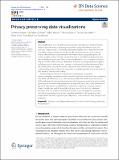| dc.contributor.author | Avraam, Demetris | |
| dc.contributor.author | Wilson, Rebecca | |
| dc.contributor.author | Butters, Oliver | |
| dc.contributor.author | Burton, Thomas | |
| dc.contributor.author | Nicolaides, Christos | |
| dc.contributor.author | Jones, Elinor | |
| dc.contributor.author | Boyd, Andy | |
| dc.contributor.author | Burton, Paul | |
| dc.date.accessioned | 2021-09-20T17:41:13Z | |
| dc.date.available | 2021-09-20T17:41:13Z | |
| dc.date.issued | 2021-01-07 | |
| dc.identifier.uri | https://hdl.handle.net/1721.1/131977 | |
| dc.description.abstract | Abstract
Data visualizations are a valuable tool used during both statistical analysis and the interpretation of results as they graphically reveal useful information about the structure, properties and relationships between variables, which may otherwise be concealed in tabulated data. In disciplines like medicine and the social sciences, where collected data include sensitive information about study participants, the sharing and publication of individual-level records is controlled by data protection laws and ethico-legal norms. Thus, as data visualizations – such as graphs and plots – may be linked to other released information and used to identify study participants and their personal attributes, their creation is often prohibited by the terms of data use. These restrictions are enforced to reduce the risk of breaching data subject confidentiality, however they limit analysts from displaying useful descriptive plots for their research features and findings.
Here we propose the use of anonymization techniques to generate privacy-preserving visualizations that retain the statistical properties of the underlying data while still adhering to strict data disclosure rules. We demonstrate the use of (i) the well-known k-anonymization process which preserves privacy by reducing the granularity of the data using suppression and generalization, (ii) a novel deterministic approach that replaces individual-level observations with the centroids of each k nearest neighbours, and (iii) a probabilistic procedure that perturbs individual attributes with the addition of random stochastic noise. We apply the proposed methods to generate privacy-preserving data visualizations for exploratory data analysis and inferential regression plot diagnostics, and we discuss their strengths and limitations. | en_US |
| dc.publisher | Springer Berlin Heidelberg | en_US |
| dc.relation.isversionof | https://doi.org/10.1140/epjds/s13688-020-00257-4 | en_US |
| dc.rights | Creative Commons Attribution | en_US |
| dc.rights.uri | https://creativecommons.org/licenses/by/4.0/ | en_US |
| dc.source | Springer Berlin Heidelberg | en_US |
| dc.title | Privacy preserving data visualizations | en_US |
| dc.type | Article | en_US |
| dc.identifier.citation | EPJ Data Science. 2021 Jan 07;10(1):2 | en_US |
| dc.contributor.department | Sloan School of Management | |
| dc.identifier.mitlicense | PUBLISHER_CC | |
| dc.eprint.version | Final published version | en_US |
| dc.type.uri | http://purl.org/eprint/type/JournalArticle | en_US |
| eprint.status | http://purl.org/eprint/status/PeerReviewed | en_US |
| dc.date.updated | 2021-01-10T04:14:46Z | |
| dc.language.rfc3066 | en | |
| dc.rights.holder | The Author(s) | |
| dspace.embargo.terms | N | |
| dspace.date.submission | 2021-01-10T04:14:46Z | |
| mit.license | PUBLISHER_CC | |
| mit.metadata.status | Authority Work and Publication Information Needed | |
